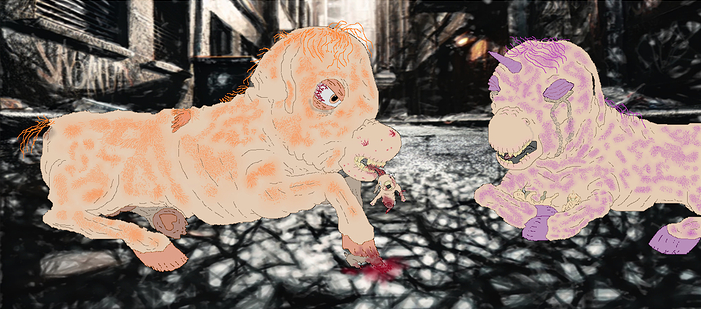As the harsh grip of late autumn tightens its hold on the feral fluffy population, the struggle for survival among its most vulnerable members becomes an increasingly desperate affair. This documentary segment focuses on a mare and stallion trapped in a back alley, facing the final stages of their lives. With limited resources and no means to escape their fate, their physical and mental deterioration exemplifies the fragile existence of fluffies left to fend for themselves without human care.
Months of dwindling food supplies and harsh conditions have taken a profound toll on the mare and stallion’s bodies. Their once vibrant and plush coats, engineered for tactile appeal and aesthetic value, have thinned significantly. Large patches of fur are missing, exposing raw, irritated skin to the cold air. The remaining fur is dull and matted, a far cry from its original state. This fur loss, exacerbated by malnutrition, reflects their body’s inability to maintain even the most basic aspects of health due to a lack of nutrients and energy reserves.
Their manes and tails, which once flowed as symbols of fluffies’ cheerful design, have largely fallen away. Strands hang limp and brittle, breaking off in small clumps. This loss further underscores their poor health and the body’s inability to preserve non-essential structures during prolonged starvation.
The mare and stallion’s muscle mass has wasted away, leaving them frail and weak. Their legs tremble under the strain of supporting their own weight, and their movements are slow and labored. The once round, robust bodies engineered for play and companionship have become skeletal, each rib starkly visible. Muscle atrophy leaves them vulnerable to injury and unable to adequately forage or defend themselves, perpetuating the cycle of decay.
Their teeth, never well-suited to the harsh realities of a feral existence, are now deteriorating rapidly. Engineered to chew soft, nutrient-rich food provided by humans, their teeth have become worn, cracked, and yellowed from scavenging unsuitable materials. This deterioration exacerbates their malnutrition, as they can no longer chew even the scarce food they may find, leading to further physical decline.
The mental state of the mare and stallion has also deteriorated in response to their prolonged suffering. Fluffies are engineered for simplistic thought processes and emotional displays, but the extreme stress of starvation and isolation has driven them to desperate and erratic behavior. The stallion’s choice to cannibalize one of their foals reflects the collapse of his programmed instincts under the weight of necessity. Hunger overrides any semblance of reason, reducing him to a state of primal survival. This act, while horrific, is a testament to the depth of his desperation and the complete breakdown of his mental faculties.
Meanwhile, the mare clings to the remnants of her maternal programming. She cradles her remaining foals, weeping uncontrollably at the loss and the grim reality that she cannot save them. Her coddling behavior is a hollow echo of her intended purpose as a caretaker, now rendered futile by starvation and impending death. The mare’s grief, compounded by physical exhaustion, leaves her unable to take meaningful action, trapped in a state of passive despair.
Both fluffies exhibit behaviors indicative of severe psychological stress, including erratic movements, bouts of crying, and periods of unresponsiveness. These symptoms mirror the mental degradation caused by prolonged malnutrition, isolation, and the overwhelming knowledge of their predicament. Their minds, much like their bodies, are in the final stages of collapse, leaving them unable to comprehend or escape their fate.
The decline of this mare and stallion serves as a poignant reminder of the fragility of feral fluffy life. Their engineered design, intended for comfort and companionship, leaves them ill-equipped to survive the brutal conditions of the wild. As winter approaches, their thinning fur, deteriorating bodies, and fractured minds foreshadow an inevitable end. Trapped in a cycle of starvation, grief, and physical decay, their existence is a tragic testament to the limitations of genetic engineering and the unyielding cruelty of nature when faced with inadequate adaptation.
